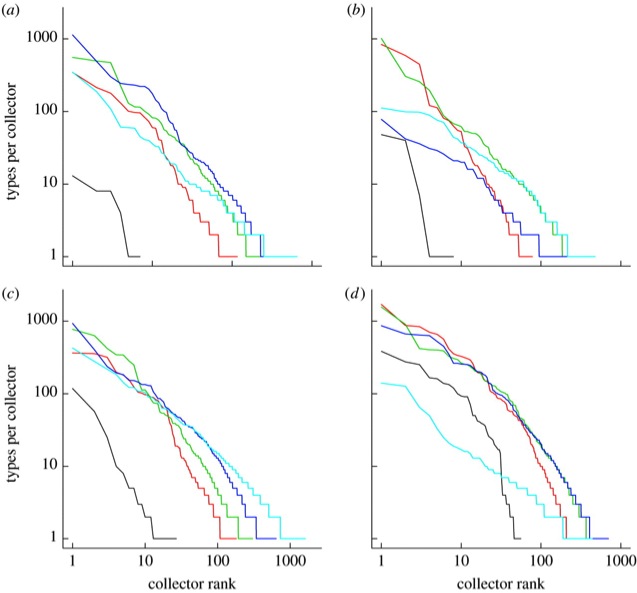
[Adapted in part from my recent review at Faculty of 1000]
In an important sense, nothing exists until it’s given a name. And in the living world of organisms, names—official, scientific names—are assigned by unique creatures called taxonomists, experts in the minutiae of structure and biology of particular groups of organisms, working according to a strict and arcane body of rules of biological nomenclature. These individuals tend to be specialists—sages of whales, anglerfishes, microscopic worms that live only between the grains of sand on beaches, microscopic algae, purple sulfur bacteria, and everything in between.
Taxonomy is not widely seen as a sexy field of endeavor. It lacks the cache of, say, hunting the giant squid or whale shark. Taxonomy is sometimes derided as stamp collecting and so on by those at the vigorous forefront of the “real” sciences, or at least it was before it became politically correct to bemoan the ongoing free fall of global biodiversity and pronounce that we need more taxonomists.
But where would we be without it?
 I will confess, I did not appreciate the importance of taxonomy in my wayward scientific youth. I vividly remember arriving at the Smithsonian’s National Museum of Natural History as a new postdoc in 1990. I landed in the Crustacea section. It was a dim and dusty place, its long hallways hung with portraits (few of them smiling) of the great carcinologists of old, the occasional click-clack of a typewriter (yes, a typewriter) chattering in the background. At the time, this single floor of the venerable building on Constitution Avenue (separated by locked doors from the rotunda with Teddy Roosevelt’s famous elephant and the seething crowds flowing past it) was populated by most of the world’s great crustacean biologists of the 20th century. Not a one was under the age of 55 and most were much older. Fenner Chace, a prolific taxonomist of shrimps, had published his first paper in 1935. 1935!
I will confess, I did not appreciate the importance of taxonomy in my wayward scientific youth. I vividly remember arriving at the Smithsonian’s National Museum of Natural History as a new postdoc in 1990. I landed in the Crustacea section. It was a dim and dusty place, its long hallways hung with portraits (few of them smiling) of the great carcinologists of old, the occasional click-clack of a typewriter (yes, a typewriter) chattering in the background. At the time, this single floor of the venerable building on Constitution Avenue (separated by locked doors from the rotunda with Teddy Roosevelt’s famous elephant and the seething crowds flowing past it) was populated by most of the world’s great crustacean biologists of the 20th century. Not a one was under the age of 55 and most were much older. Fenner Chace, a prolific taxonomist of shrimps, had published his first paper in 1935. 1935!
The way these taxonomists worked had changed little over time. Most of my colleagues at the Museum were doing more or less the same thing that their counterparts had done a century earlier, or even two, as they opened packages sent home by Darwin or Wallace or the Challenger expedition. Most spent their days in the solitary pursuit of dissecting and minutely inspecting specimens of small crustaceans through a microscope, carefully drawing the diagnostic features that separate this type from another, writing detailed descriptions of these differences, and publishing them in scientific journals that are largely unknown to anyone outside the field.
Every last one of those venerable Smithsonian crustacean biologists is now gone. There are others of course, but the silverbacks of the 20th century are gone. Into the void has come a new era of taxonomy trying to come to grips with the sheer enormity of the task of getting a handle on earth’s profound biological heritage before it is, as the expression goes, gone with the wind. The field of species description, identification, and classification is now in ferment. Most of us are painfully aware that we are losing biodiversity rapidly. But what about the loss of experts who can understand it?
While it becomes easier by the day to census biodiversity via molecules alone, would these bioinformatic arcana mean anything to us without the knowledge that they are the signatures of fantastic and unique living organisms? DNA Barcoding has its place, as does twitter. But they are only surface ripples that alert us to events in the profound depths below. Our apprehension of the world’s spectacular biodiversity—and what’s at stake with its accelerating loss—would be largely impossible without the foundation of taxonomy. And field discovery is in turn the foundation of taxonomy.
 So what is the foundation of field discovery? A new paper by Bebber et al. shows that it turns out to be primarily the achievement of a small cadre of masters or “big hitters”. The authors focus on land plants but the story would surely be similar for most other major groups of organisms. Analyzing > 100,000 records of plant species discovery and description from four major world collections, the authors find that the history of plant discovery is dominated by a small group of highly productive collectors: over half the described species of plants were first collected by fewer than 2% of individual collectors.The graphs at right show, for four different museum collections, the number of “type” specimens (first of a new species) were found by each collector, ranked from most to least. Th different colors denote different time periods: 1700–1800 (black), 1801–1850 (red), 1851–1900 (green), 1901–1950 (dark blue), 1951–2011 (light blue). Note that these are on a log-log scale. They show, for example, that the most prolific early collector (black line) in the Missouri Botanical Garden collection (panel c) found over 100 new species, while most of his compatriots found fewer than 10.
So what is the foundation of field discovery? A new paper by Bebber et al. shows that it turns out to be primarily the achievement of a small cadre of masters or “big hitters”. The authors focus on land plants but the story would surely be similar for most other major groups of organisms. Analyzing > 100,000 records of plant species discovery and description from four major world collections, the authors find that the history of plant discovery is dominated by a small group of highly productive collectors: over half the described species of plants were first collected by fewer than 2% of individual collectors.The graphs at right show, for four different museum collections, the number of “type” specimens (first of a new species) were found by each collector, ranked from most to least. Th different colors denote different time periods: 1700–1800 (black), 1801–1850 (red), 1851–1900 (green), 1901–1950 (dark blue), 1951–2011 (light blue). Note that these are on a log-log scale. They show, for example, that the most prolific early collector (black line) in the Missouri Botanical Garden collection (panel c) found over 100 new species, while most of his compatriots found fewer than 10.
Although big hitters tend to have long careers and broad taxonomic expertise as might be expected, other results are more surprising: this pattern is remarkably similar today as it was for collectors in the 18th century (i.e., different color curves have similar shapes in the figure), and applies to low- as well as high-diversity geographic regions, and to both poorly known and well-studied areas.
The key to a prolific record of discovering new species, according to this analysis, is “the critical role of expertise gained from many years spent in the field”.
What does this mean? Among the uninitiated, it’s commonly assumed that taxonomists “find” new species in a willy nilly fashion as they wander around turning over logs or rooting through coral reefs. Such rooting around is, obviously, a key part of taxonomic discovery. But the results of this analysis hint that the process is much more akin to the way that a brilliant molecular geneticist “finds” a fundamentally new pattern of gene evolution or expression—in both cases, the discovery is guided by both detailed expertise and a keen intuition honed by intensive study into a synthetic knowledge of both the living thing and its environment (whether ecological or biochemical). Like most great accomplishments this discovery is an art as much as a science, and allows the expert to reach eureka that few others would have recognized.
I’m not by any means a ‘big hitter’ of collecting or taxonomy. But almost in spite of myself, in spite of my entry into the field of biology as an ecologist (well, actually I made a brief debut studying ultrastructure of flatworms but that’s a story for another day), I was inexorably led into taxonomy by necessity, a story common to students of all marine invertebrates apart form the most conspicuous and charismatic. And I came to see the light. In my own taxonomic work I’ve often been humbled by the dead-on insights of taxonomists who worked more than a century ago in a world, both natural and technological, that is rapidly receding beyond our comprehension. Darwin himself is of course the best known but there are many others.
 So I now see a duty to set the record straight. Although my primary field is ecology, I can attest to the very distinct romance of taxonomy. It is the logical heir of the great 19th century tradition of exploration and natural history study that employed the likes of Wallace and Humboldt and Darwin, all intrepid souls that braved sometimes unimaginable hardships largely with the simple goal of finding new things.
So I now see a duty to set the record straight. Although my primary field is ecology, I can attest to the very distinct romance of taxonomy. It is the logical heir of the great 19th century tradition of exploration and natural history study that employed the likes of Wallace and Humboldt and Darwin, all intrepid souls that braved sometimes unimaginable hardships largely with the simple goal of finding new things.
Our world today is a bit more prosaic, what with GPS, Google Earth, antibiotics, and personal flotation devices. It would be hard to get lost anywhere any more (as an aside, when I searched Google for an image of “explorer” most of the top hits were pictures of an urban assault vehicle. Sheesh). Nevertheless. There are still unknown wonders out there. There is nothing like the thrill of exploring new places, and finding completely new creatures, organisms that no one has ever seen or at least paid any attention to.
This fascinating new paper documents that, even in the high-tech modern world, there is no substitute for old-fashioned, intensive field experience for the increasingly critical discovery and documentation of biodiversity. And it has several sobering messages, among which are that, in an age of increasing (and largely constructive) focus on developing parataxonomists and citizen scientists, there is no substitute for biodiversity sages, despite being endangered species themselves.
Leave a Reply